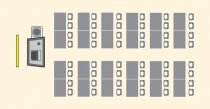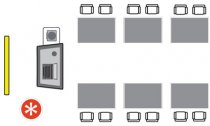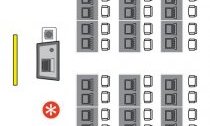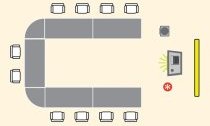room arrangments
 Every teacher likes to arrange their classroom layout for the largest student benefit. Students need to focus and see what is going on in the classroom at any given time. Their seating arrangement can help or hinder a students learning. Although no perfect arrangement exists for all situations, a classrooms layout may need to change based on what a student needs are and how the class material is being presented.
Every teacher likes to arrange their classroom layout for the largest student benefit. Students need to focus and see what is going on in the classroom at any given time. Their seating arrangement can help or hinder a students learning. Although no perfect arrangement exists for all situations, a classrooms layout may need to change based on what a student needs are and how the class material is being presented.
It is important for an instructor to establish a classroom structure from the very first session and adapt accordingly to facilitate lectures, promote discussions, encourage group activities, or solve any behavioral problems. Keeping a classroom motivated and in order is more than trying different teaching styles and methods. By simply rearranging how the desks in the room are setup, you can not only get better control of your class but create an open and friendly classroom environment.
There are generally three overall classroom desk arrangement layouts with slight variations to each to accommodate different size rooms, number of students in the class and also assist in the classes function:
- Traditional Classroom (Large or Small)
- U-Shaped Layout
- Circle or Half Circle Arrangements
Each layout has a different purpose and may require an adjustment to teaching method and classroom control. It will be up to the instructor to decide which layout works best for them and their students.
Traditional Classroom
In a tradional class all the desks are facing the chalkboard and teachers desk. This classroom layout is very effective if your lesson often uses projectors, slides and a chalkboard. The layout is suitable for teacher centered classes such as lectures, it encourages focus on the educator and content and is easy to implement with large classes. The problem with this layout is that the teacher is very far away from students sitting in the back rows. Students sitting in the last rows are more likely to be distracted, lose focus and converse with others. Students can easily become disengaged during the lesson. This layout is not useful for classes designed for conversation and interaction and not easy for the instructor to observe students in the mid and back rows.
The problem with this layout is that the teacher is very far away from students sitting in the back rows. Students sitting in the last rows are more likely to be distracted, lose focus and converse with others. Students can easily become disengaged during the lesson. This layout is not useful for classes designed for conversation and interaction and not easy for the instructor to observe students in the mid and back rows.
Large Classroom
Advantages: Rows of tables with chairs face the front of a room and each person has a space for writing or using a computer. This set-up lends itself to Q&A session with the facilitator rather than interactive discussion between participants.Disadvantages: Hard for instructor to move into the audience, separating him/her from the students. Student participation seems to drop off towards the back of the room unless sound reinforcement is used.
Action Zone: At the front of the room. Students are focused on the instructor.
Group Involvement: Medium. Allows one way interaction back and forth between instructor and audience or between the trainer and an individual in the group.
Seating: Similar to a school arrangement with participants seated behind a row of desks or tables.
Tables: Arranged in rows, either butted together side by side or standing alone.
Small Classroom
Advantages: Every participant has a good view of the front of the room. This allows the instructor a great deal of control over the students. Provides surface for note taking or reference materials.Variations of Small Classroom
Perpendicular: Tables are arranged in long rows perpendicular to the trainer’s table. The edge of the first table should be 6 feet away from the trainer’s table and a large corridor should be left in the middle to allow for group participation. Having the desks split into two groups facing each other is a very effective arrangement for class discussions and debates. The teacher can also walk in between the two groups allowing to see every student and include them in conversations.
Having the desks split into two groups facing each other is a very effective arrangement for class discussions and debates. The teacher can also walk in between the two groups allowing to see every student and include them in conversations.
Ideally, power should be supplied near every table. Wire management is a necessity with this set up to safely conceal wires around the work areas.
U-Shaped Layout
For smaller classes that want more interaction between the student and educator, a U-Shaped layout is a better option. A U-Shaped desk arrangement encourages discussion and makes it easy for the teacher to observe students and provide one on one help.Classroom size and number of students can make it difficult to use, for you may not be able to fit a U-Shape pattern in a small room with a large number of students. The layout spreads children out considerably so that it can be hard to address them all and makes group work harder because the desks can’t easily be moved around.
Advantages: Easy to see and hear everyone in the group. Front of room commands the group’s attention. Unity is created by ganging all the tables together. Openness gives trainees a sense of freedom and encourages participation. Best set up to view audio visual presentations. Works well with role-playing and other physical activities. Disadvantages: Requires more space than any other configuration. Due to space and learning requirements, the maximum amount of participants should not exceed 24.
Disadvantages: Requires more space than any other configuration. Due to space and learning requirements, the maximum amount of participants should not exceed 24.
Action Zone: Center and at the open end of the “U”.
Group Involvement: High. Creates a sense of equality within the group.
Tables: Rectangular tables set in a “U’ configuration. Pie shapes are commonly used at the corners to complete the shape and eliminate the hard edges. Trainer’s table is at the opening of the “U”.
Accommodates AV: Yes. This configuration is one of the best for visual displays and multimedia presentations. Equipment set at open end of “U”.
Variations of U-Shaped
Double “U”: Allows trainer to seat more people than single “U’ set up. Limits discussions between the group. Best used when the outside group is observing the discussions or activities of the inside group.
“U” Computer Training: Allows wires to run under the tables easily. This set up also allows the instructor to monitor student's work easily while speaking to the class.
Circle or Half Circle Arrangements
Desks or chairs arranged in a circle or half circle promote community and encourage all students to participate. Everyone sits in the front row. It also allows the instructor to see everyone from an equal distance and communicate easier with students. Advantages: Involves everyone in the group. There is no table in the middle, therefore people are unobstructed and can speak directly to each other. Creates equality among the group, with no designated “leader” position.Disadvantages: Some people feel uncomfortable or exposed in this type of arrangement. Can only handle small groups of people. Not conducive to visual aids or AV presentations.
Action Zone: Center of the circle.
Group Involvement: High. Aims to involve all participants in group interaction.




Related posts:

 Photography by: Thomas Loof A Little Paint Goes a Long Way Ah, paint. Whether you need to conceal the mysterious marks left on the wall by the last tenants or you…
Photography by: Thomas Loof A Little Paint Goes a Long Way Ah, paint. Whether you need to conceal the mysterious marks left on the wall by the last tenants or you… A bed positioned in front of a window offers a layout solution in a bedroom with numerous doors. Some bedrooms have numerous doors to contend with when you re trying…
A bed positioned in front of a window offers a layout solution in a bedroom with numerous doors. Some bedrooms have numerous doors to contend with when you re trying… This cozied-up formal dining room is wonderful for those who have a large family or group of friends and often find themselves throwing dinner parties or hosting…
This cozied-up formal dining room is wonderful for those who have a large family or group of friends and often find themselves throwing dinner parties or hosting… The Small but Mighty Dining Room This space proves that smaller dining rooms can be just as grand as their roomier counterparts. Its most clever trick? Using a round…
The Small but Mighty Dining Room This space proves that smaller dining rooms can be just as grand as their roomier counterparts. Its most clever trick? Using a round… Clean lines, sleek surfaces, sculptural forms… There’s a lot to love about contemporary furnishings, but they can come with a serious intimidation factor—especially…
Clean lines, sleek surfaces, sculptural forms… There’s a lot to love about contemporary furnishings, but they can come with a serious intimidation factor—especially…